In the realm of drumming, rudiments serve as the foundational patterns and techniques that underpin a drummer’s skill set. Among these rudiments, the drag paradiddle stands out as a category that combines the grace of drags with the rhythmic power of paradiddles. The drag paradiddle is a unique and versatile rudiment that adds a layer of complexity and nuance to a drummer’s repertoire. In this article, we will explore the world of drag paradiddle rudiments, understand what they are, how to practice them, and their significance in the drummer’s toolkit.
Understanding the Drag Paradiddle Rudiment
The drag paradiddle is a combination of two essential rudiments: drags and paradiddles. As a result, it features a series of grace notes followed by accented notes, often presented in paradiddle form. This rudiment is characterized by a softer, unaccented grace note, followed by a full-volume accented note.
The notational representation of the drag paradiddle may include the letter “D” (representing the drag) followed by the letter “P” (representing the paradiddle) and then the appropriate notation for the drag paradiddle pattern.
The drag paradiddle adds complexity, dynamics, and subtle accents to drumming patterns, making it a valuable technique for creating nuanced and expressive performances.
Practicing Drag Paradiddle Rudiments
Mastering the drag paradiddle requires dedicated practice and attention to detail. Here are the steps to effectively practice drag paradiddle rudiments:
- Hand Position: Start with proper hand positioning. Maintain a relaxed grip on the drumsticks, and keep your wrists and fingers flexible.
- Begin Slowly: Initiate your practice at a slow and manageable tempo. Focus on executing the grace notes and accented notes with precision.
- Use a Metronome: Practicing with a metronome is beneficial for developing timing and maintaining a consistent tempo.
- Controlled Drag Strokes: Concentrate on playing the grace note and accented note with control. The grace note should be played slightly ahead of the accented note for a noticeable drag effect.
- Gradually Increase Speed: As you become more comfortable, increase the speed of your drag paradiddle rudiments. The goal is to maintain a smooth and controlled sound while executing the pattern.
- Dynamic Control: Work on playing drag paradiddles at various dynamic levels. Practice both soft and loud patterns to build control and finesse.
- Rhythmic Variations: Experiment with incorporating drag paradiddles into different drumming patterns and fills to enhance their rhythmic complexity and versatility.
Significance of Drag Paradiddle Rudiments
Drag paradiddle rudiments are significant for several reasons:
- Complex Rhythms: They introduce complex rhythmic patterns into drumming, enhancing the musicality of performances.
- Subtle Accents: Drag paradiddles add subtle dynamic accents and nuances, making drumming patterns more interesting and engaging.
- Versatility: They can be applied to various drumming styles and contexts, allowing drummers to express themselves in diverse musical settings.
- Creative Expression: Drag paradiddles provide drummers with a creative avenue to express themselves and add unique flair to their drumming.
- Building Drumming Vocabulary: These rudiments expand a drummer’s vocabulary, allowing for more dynamic and expressive performances.
In conclusion, drag paradiddle rudiments are essential components of a drummer’s skill set, offering a unique and versatile technique for enhancing drumming performances. By mastering drag paradiddles, drummers can add layers of complexity, dynamics, and expressive nuances to their drumming, creating engaging and captivating performances across a variety of musical genres and settings.


